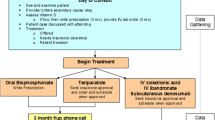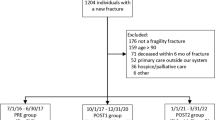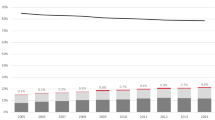Abstract
Summary
Geisinger Health System (GHS) high-risk osteoporosis clinic (HiROC), which treats patients with low-trauma, fragility fractures, reports their 2013–2015 performance measures in secondary fracture prevention. This fracture liaison service (FLS) pathway treats 75% of high-risk, drug eligible patients, compared to 13.8% in GHS primary care. This performance points to the need for more FLS programs throughout the world.
Introduction
The purpose of this study is to analyze and report ongoing performance measures in outpatient and inpatient high-risk osteoporosis clinic (HiROC) program designed for patients with low-trauma, fragility fractures.
Methods
Retrospective chart review of outpatient HiROC (511 patients) and inpatient HiROC (1279 patients) performance from 2013 to 2015 is reported within Geisinger Health System (GHS).
Results
Similar to a prior report, we document that Geisinger’s branded outpatient and inpatient HiROC pathways continue to function as an all-fracture FLS. Importantly, this analysis emphasizes the importance of FLS care that HiROC’s treatment rate of 75% was markedly superior to GHS-PCP care of 13.8%. However, a large percentage of patients (37.8%) were lost to follow-up care. This led to the identification of multiple care gaps/barriers to ideal best practice.
Conclusions
FLS programs use case finding strategies and address secondary fracture prevention. GHS HiROC’s performance and initiation of drug therapy in this fracture patient population contrasts with GHS-PCP care’s much lower rate of treatment, documenting the need for ongoing FLS care. Importantly, the results of this analysis have prompted the beginnings of GHS programmatic changes, designed to narrow the reported care gaps in this mature FLS.


Similar content being viewed by others
References
Olenginski TP, Maloney-Saxon G, Matzko CK, Mackiewicz K, Kirchner HL, Bengier A, Newman ED (2014) High-risk osteoporosis clinic (HiROC): improving osteoporosis and postfracture care with an organized, programmatic approach. Osteoporos Int 26(2):801–810
Grossman JM, Gordon R, Ranganath VK, Deal C, Caplan L, Chen W, Curtis JR, Furst DE, Mcmahon M, Patkar NM, Volkmann E, Saag KG (2010) American college of rheumatology 2010 recommendations for the prevention and treatment of glucocorticoid-induced osteoporosis. Arthritis Care Res 62(11):1515–1526 Web
Viprey M, Caillet P, Canat G, Jaglal S, Haesebaert J, Chapurlat R, Schott A-M (2015) Low osteoporosis treatment initiation rate in women after distal forearm or proximal humerus fracture: a healthcare database nested cohort study. Plos One 10(12):e0143842 n. pag. Web
Dore N, Kennedy C, Fisher P, Dolovich L, Farrauto L, Papaioannou A (2013) Improving care after hip fracture: the fracture? Think osteoporosis (FTOP) program. BMC Geriatr 13(1): n. pag. Web
Queally JM, Kiernan C, Shaikh M, Rowan F, Bennett D (2012) Initiation of osteoporosis assessment in the fracture clinic results in improved osteoporosis management: a randomised controlled trial. Osteoporos Int 24(3):1089–1094 Web
Eisman JA, Bogoch ER, Dell R, Harrington TR, McKinney RE Jr, McLellan A, Mitchell PJ, Silverman S, Singleton R, Siris E (2012) Making the first fracture the last fracture: ASBMR task force report on secondary fracture prevention. JBMR 27(10):2039–2046
Sale JEM, Beaton D, Posen J, Elliot-Gibson V, Bogoch E (2011) Systematic review on interventions to improve osteoporosis investigation and treatment in fragility fracture patients. Osteoporos Int 22:2067–2082
Giangregorio L, Papaioannou A, Cranney A, Zytaruk N, Adachi JD (2006) Fragility fractures and the osteoporosis care gap: an international phenomenon. Semin Arthritis Rheum 35:293–305
Buckley L, Guyatt G, Fink HA, Cannon M, Grossman J, Hansen KE, Humphrey MB, Lane NE, Magrey M, Miller M, Morrison L, Rao M, Robinson AB, Saha S, Wolver S, Bannuru RR, Vaysbrot E, Osani M, Turgunbaev M, Miller AS, Mcalindon T (2017) 2017 American college of rheumatology guideline for the prevention and treatment of glucocorticoid-induced osteoporosis. Arthritis Rheumatol 69(8):1521–1537 n. pag. Web
Siris ES, Adler R, Bilezikian J, Bolognese M, Dawson-Hughes B, Favus MJ, Watts NB (2014) The clinical diagnosis of osteoporosis: a position statement from the national bone health alliance working group. Osteoporos Int 25(5):1439–1443
Olenginski TP, Antohe JL, Sunderlin E, Harrington TM (2011) Appraising osteoporosis care gaps. Rheumatol Int 32(11):3619–3624 Web
Newman E, Olenginski T, Perruquet J, Hummel J, Indeck C, Wood G (2004) Using mobile DXA to improve access to osteoporosis careunit design, program development, implementation, and outcomes. J Clin Densitom 7(1):71–75 Web
Oppermann B, Ayoub W, Newman E, Wood GC, Olenginski TP (2010) Consultative DXA reporting improves guideline-driven quality of care—implications for increasing DXA reimbursement. J Clin Densitom 13(3):315–319
Acknowledgements
This manuscript is dedicated to the unwavering spirit of our entire HiROC team, to our partners in our East and West geographic regions, to Karen Mackiewicz, Cindy Matzko, RN, Gwynne Maloney-Saxon, RN, Mary Butterwick, RN, and to our secretaries, scheduling staff, and infusion teams throughout GHS.
Author information
Authors and Affiliations
Corresponding author
Ethics declarations
Conflicts of interest
Philip Dunn and Deb Webb declare that they have no conflict of interest. Thomas Olenginski serves as a consultant to Amgen, currently working on a medication mining project with Amgen, and serves on Amgen Speaker’s Bureau.
Rights and permissions
About this article
Cite this article
Dunn, P., Webb, D. & Olenginski, T.P. Geisinger high-risk osteoporosis clinic (HiROC): 2013–2015 FLS performance analysis. Osteoporos Int 29, 451–457 (2018). https://doi.org/10.1007/s00198-017-4270-2
Received:
Accepted:
Published:
Issue Date:
DOI: https://doi.org/10.1007/s00198-017-4270-2




